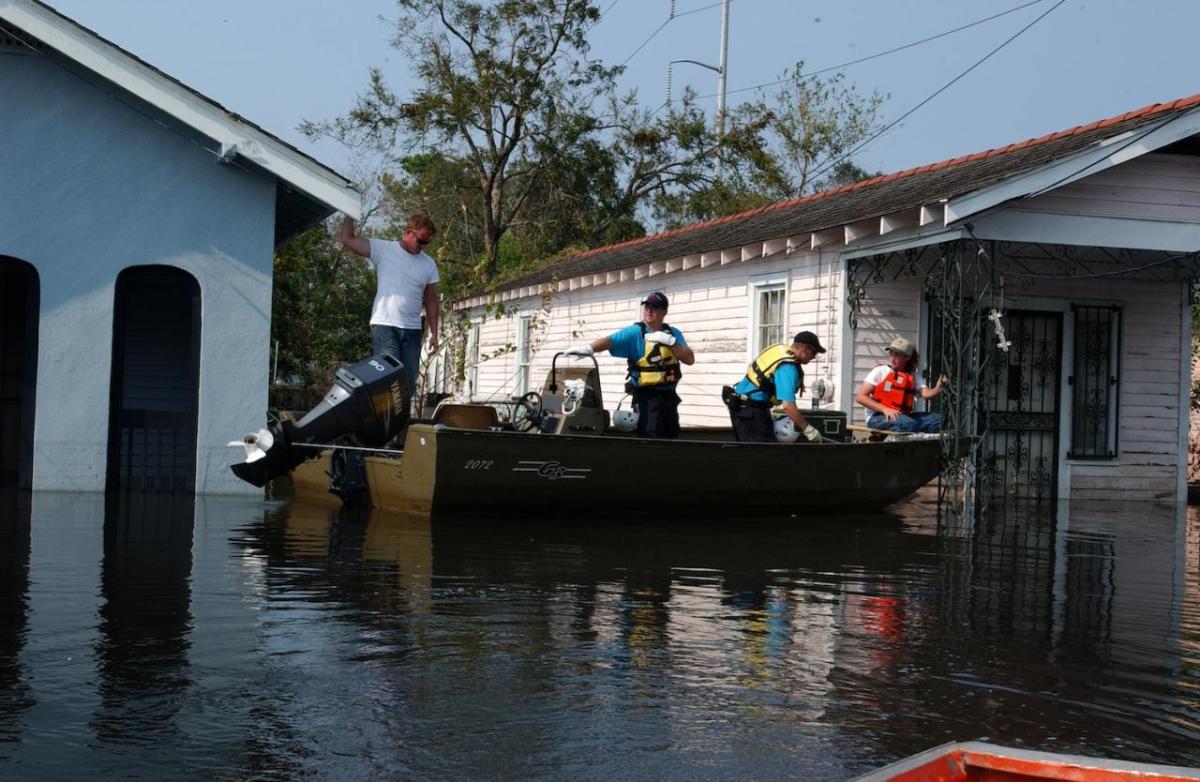What We Learned (Or Didn’t) From Hurricane Katrina
Hurricane Katrina sounded the alarm that disaster preparedness was vastly inadequate in the U.S. Two decades later, Americans are considering the changes made since and whether they’re working.

Originally published on TriplePundit
By Taylor Haelterman
This story about Hurricane Katrina is part of The Solutions Effect, a monthly newsletter covering the best of solutions journalism in the sustainability and social impact space. If you aren’t already getting this newsletter, you can sign up here.
Two decades ago, Americans were horrified by the response to Hurricane Katrina and the devastation it left behind. It was a wake-up call that rang around the nation, sounding the alarm that the current level of disaster preparedness was vastly inadequate. People across the country demanded action. Policies changed. Levees were rebuilt. Warning systems advanced. And we have not forgotten Katrina.
Still, 85 percent of Americans are familiar with the disaster, according to a USA Today poll. That includes 75 percent of those aged 18 to 34, some of whom were born after it occurred. As the country looks back at 2005, solutions journalists are investigating whether the changes we’ve made since are making an impact.
$14 billion levees
The failure of the city’s levee system led to much of the damage dealt by Hurricane Katrina in New Orleans. Sections of the 125 miles of flood barricades built around the city by the United States Army Corps of Engineers were too small or erected with serious engineering mistakes. The levees failed in six places. Water rushed over the top or broke the walls entirely, igniting a humanitarian crisis.
Afterward, the U.S. government doubled down, footing a $14.4 billion bill to build a new network of levees across the city. Over the next 10 years, the Army Corps of Engineers constructed nearly 200 miles of flood barriers known as one of the most sophisticated systems across the globe, and it held during Hurricane Issac in 2012 and Hurricane Ida in 2021, Grist reports.
Still, experts worry the upgraded levees might not live up to the original promise to protect against a “hundred-year storm,” a term used to describe rare and powerful storms with a 1 percent chance of forming each year. Hurricane Katrina was widely considered a 100-year storm, and these events are growing more common. Dozens of hundred-year flooding events swept through communities across the United States last year alone. Hurricane Helene, which caused widespread damage across Florida and devastating floods in western North Carolina last year, and the catastrophic flooding in Texas this summer were considered once-in-1,000-year events.
Therein lies the problem for New Orleans’ levees. As the city slowly sinks, the Gulf of Mexico steadily rises, and storms become more severe, the barriers struggle to keep up — even after factoring in climate change and sea-level rise from the start. The Corps told Grist the levees will protect the city from 100-year storms through 2057 as long as it can afford to keep lifting them every few years. Though the New Orleans branch of the organization announced it didn’t have the funds to inspect them this year due to federal budget cuts, it later received funding from the St. Louis branch to do so. While imperfect, the system will still reduce the damage from more-than-100-year storms, and it demonstrates what can be done to get out in front of a disaster instead of acting afterward. Read more.
Earlier warnings
When Hurricane Katrina was first tracked, it was never expected to hit Louisiana or grow from Category 1 to Category 5 intensity. The devastation that followed left the country hyperaware of the gaps in our ability to forecast storms, and therefore, our ability to prepare for and respond to them. Since then, the systems for predicting the path and strength of a hurricane have improved dramatically, Science News reports.
The National Oceanic and Atmospheric Administration (NOAA) created the Hurricane Forecast Improvement Program in response to Hurricane Katrina and other storms in 2004 and 2005. It brought together agencies and labs across the nation to make more accurate, reliable forecasts that give communities time to prepare. Now, scientists use satellites to observe weather data multiple times a day, and more powerful computers accompanied by a better understanding of the science behind storms allow for more accurate predictions. Researchers also collect and use real-time storm data, which helps anticipate rapid changes in direction and strength.
As a result, tracking errors have shrunk by about half — sometimes shrinking by well over 50 percent — even days in advance of a storm reaching land. That means storm path estimates are very unlikely to shift by 200 miles in just 12 hours, like they did in the case of Katrina. The Hurricane Forecast Improvement Program is still working toward even earlier forecasts, but federal funding and staff cuts currently leave much of its work uncertain. While a four-day warning doesn’t allow much time for damage prevention like raising New Orleans’ levees, it is enough time to take action that saves lives, like evacuations and delivering emergency generators to hospitals. Read more.
A federal law protecting pets
Millions of Americans have pets, and when disaster strikes, they’re often left with a horrible decision. First responders don’t always allow people to evacuate with their pets. Even if they do, many emergency shelters and hotels don’t allow pets. And Hurricane Katrina was no different, Atmos reports. Roughly a quarter of a million cats and dogs were displaced or died during the storm. While the vast majority of Americans plan to evacuate with their pets, many have had to leave them behind and return to the disaster site before it’s considered safe to try and rescue them. A 2015 study found that pets are the biggest reason people refuse evacuation orders.
That’s why the Pets Evacuation and Transportation Standards Act of 2006 was passed. It ensures that state and local emergency managers include pets in emergency preparedness plans and federal agencies help pet owners and their pets. It also lets the federal government reimburse state and local governments for the cost of sheltering pets. “People consider their pets to be family,” Ashley Farmer, a pet disaster response researcher at Illinois State University, told Atmos. “If you include pets in disaster planning, you will ultimately also save human lives.”
Though experts say the act made an important impact, its implementation is left up to state and local governments. Some still essentially leave pets out of their emergency plans with statements like “people are responsible for their pets.” Read more.
Learning from emergency management mistakes
Emergency management and response failed in different areas at all levels of government during Katrina, Eric Kevin Stern, crisis and emergency management specialist and professor, argues in an article for The Conversation. Communication between agencies was ineffective. The state had to request a disaster declaration before the Federal Emergency Management Agency (FEMA) could move in. Evacuees were trapped in the Superdome with no power and few supplies, and people who couldn’t evacuate in time were stranded on their roofs.
In the aftermath, policies changed. The Post-Katrina Emergency Management Reform Act of 2006 mandates that FEMA chief administrators have knowledge and experience in emergency management and leadership, something then-FEMA Administrator Michael Brown lacked. The National Incident Management System was widely adopted after the storm, allowing all levels of government, local organizations, and the private sector to communicate and work together, replacing the communication and coordination chaos that erupted when systems broke down after Katrina. FEMA was also permitted to start working before a storm arrives and before a disaster declaration is requested, so survivors aren’t left waiting for help, like when political tensions reportedly delayed former President George W. Bush’s approval of New Orleans’ request.
Today, the federal government is discussing reducing or dismantling FEMA, placing more emergency management responsibility on local and state governments instead. But states and cities vary in their readiness to do so, and experts warn many are simply unprepared and lack the necessary funds. If more responsibility is shifted to states, we must remember the lessons learned from Katrina and ensure they have the ability to effectively coordinate and respond to disasters, Stern concludes. Read more.
That message rings especially true as New Orleans continues to grapple with the social, economic, and environmental effects of the hurricane 20 years later.
Dive deeper into this solution:
After Katrina, green infrastructure aims to supplement the rebuilt — but still vulnerable — levees, Smart Cities Dive
One of Hurricane Katrina’s most important lessons isn’t about storm preparations – it’s about injustice, The Conversation
After Hurricane Katrina, moms built new lives by building homes, The 19th
Image credit: Jocelyn Augustino/Wikimedia Commons

